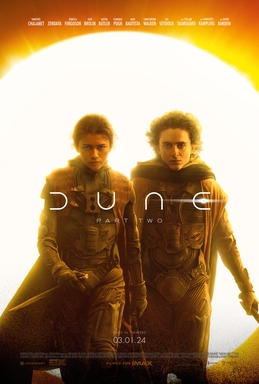Eye For Film >> Movies >> Dune: Part Two (2024) Film Review
Dune: Part Two
Reviewed by: Andrew Robertson

Dune was first published as serials, starting in 1963. 60 years later it sits within an uncomfortable franchise. Frank Herbert wrote five sequels before his death in 1986, an 'Encyclopedia' whose canonicity was imperfect even at the time. Easy enough to consider that a road not travelled, like Alan Dean Foster's Splinter Of The Mind's Eye, a sequel to Star Wars (1977) published in 1978. Easier still to look at the 19 novels published by Herbert's son Brian in the last 20 years, co-written with Kevin J Anderson whose bibliography is as rich with recognisable franchises as Foster's, though the proportions of novelisations to spin-offs is almost inverted.
All this talk of writing is in part an introduction to a parting of the ways. There are two Dunes, the film itself and the adaptation. Two Dunes, this a part two of Denis Villeneuve's interpretation. At least the third feature filmed attempt, past failures by Jodorowsky and Lynch other roads not travelled. I say past failures because I was withholding judgement on this Dune as a project when I reviewed the first part, and having seen the second it is not favourable. That's of two minds, however. If, like me, you've read (and re-read) the book there is another review for you. Beware though that it is rife with what might constitute spoilers if you have not pored over those pages previously.

Here I hope to discuss Dune: Part Two as a film, sequel to another film. It is not an easy task, and I apologise if echoes of the book creep in. I'll start with one of those gifts of prophecy, an ending foreseen. I do not think that part two represents a successful conclusion.
Before we see anything we hear, chanting against the blackness. Sardaukar? Harkonnen? Fremen? Whose battle-hymn? It matters not. It is the sound of war, and after the logos of various combines mercantile it will be burning bodies. That's the closest you will get to seeing what has gone before. Part Two assumes you have done your homework, that you are a returner. If a funeral pyre is a guiding light it is one that does not, cannot, attempt to hold your hand. It will tell you that "Power over spice is power over all," but there are other sources of power. Word and deed. Sound and vision.
Remember that Jamis was dead, to begin with. Paul Atreides (Timothée Chalamet) will gain other names here - Muad-dib, the Lisan-al-Gaib - but how he is called is not his calling. His visions, as huge upon the screen as the sand, are of burning, starving, unleashing. His solace the Fremen Chani (Zendaya), the actions of his mother Jessica (Rebecca Ferguson) those of an ally with complicated history. The Bene Gesserit have found a deep state of being within the Empire, they have the ear of Shaddam IV (Christopher Walken) and the whole of Princess Irulan (Florence Pugh). Their workings may be behind veils but and closed doors but their influence on history is written on more sheets than paper.
Villeneuve again co-writes with Jon Spaihts (Prometheus, 2017's The Mummy) and while as a sequel to a novel is a doubly-adapted screenplay by Academy rules, there are doublings everywhere. Most frustratingly an echo of something unique to their Dune, the sense of a matadorial relation to prophecy. Due to accidents of release dates audiences, will not have a choice between films with long publishing legacies involving weird powers and fortune-telling foes that underserve their female characters, but Madame Web has even less to commend it. Dune at least looks, sounds, amazing, though not always.
Sequences of storms recall the brazen imagination of Mad Max upon the Fury Road, but what's been done before in hallucinatory hues and black and chrome is just dun here. The leering sandworms are connected to the spice that lights the way but their lamprey likeness does not convince when ridden. There are echoes of other attempts, aftershocks and Tremors. In trying to thread these worms just irritate. Huddled on them, the Fremen could be immigrants atop a train, tankovy on the Eastern front, but even wrapped in wicker baskets they do not quite succeed at transporting. More lacklustre than locomotive, and indicative of how other animals are handled.
The matador appeared a few times in Part One, a statue, a story, a painting and so on. There's an arena here, capering rodeo clowns drawn by Brom (not Giger) and spears to slow them. The redirection of force, the diversionary, and again and again for me at least a sense that this reading was me reaching. Seeking pattern where there was none, knowing in part that pattern had been removed. I looked for this because I remembered it from the first part, though Paul remembers something differently. The Jamis (Babs Olusanmokun) that appears to him might be a djinn, a voice to tempt him as he wanders the wilderness.
The religious iconography of a foretold prophet wandering the desert alone is so obvious as to be inescapable. Harder to pin down is the film's own prophesising, what it has told us we will go on to do. In some of this there are different borrowings. An eclipse, a child, and we are brought back and forth to 2001: A Space Odyssey. Five years after the novel, in 1968. Eight-thousand years and change before the novel, assuming that the hundred-and-second century of the diaries from the Imperial Palace have the same starting point. Another inescapable conjunction, even if the moons are different, the black monolith a silver sphere, the skull crushed not beneath a lever but a rock.
There are moments of visual poetry. Paul lying in state with two worlds on either side of him, the steps of a pool of water and the parallel steps of a pit of sand an echo of his journey to a place between. There are moments of grandeur, deserts lit by great fires as every last erg of energy is put to use. There are moments of tension, those shields and lift-belts a reminder that even if tactics amount to running at each other in mobs this is still, somehow, the far future.
New enemies too. Beneath a blistering sky and fireworks whose wet blossoms recall the heptapod excretions of Arrival, we spend time on Geidi Prime. The Lady Fenring (Lea Seydoux), another Bene Gesserit, takes the measure of Feyd Rautha (Austin Butler), a na-baron who would be king though his lineage as Harkonnen has more than the shade of Elvis. Old friends, of course. Josh Brolin returns as Gurney Halleck - one would think the Atreides followers of Ymgarl's four-armed Emperor given how many right-hands they have. That fondness echoed in Stilgar (Javier Bardem), who does not see the young pup Paul was but the mouse he is fated to be.
Fate perhaps the underlying issue. This is not described as an ending, but a 'part two'. It has one, but one that I did not find satisfying. Not because I had read the book, that is a different feeling, but because I had spent five and one quarter hours to get here. I cannot know how much interference behind the scenes shaped what we have here, at least not yet, but Jodorowsky's Dune and David Lynch's would suggest precedent. There was no certainty of a sequel but with this much invested I am not sure how happy anyone would be with what they get. It might seem that I stamp my feet in petulance, but that is a symptom not of frustration but powerlessness.
Reviewed on: 21 Feb 2024



















